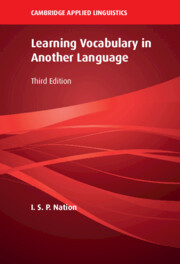Book contents
- Learning Vocabulary in Another Language
- The Cambridge Applied Linguistics Series
- Learning Vocabulary in Another Language
- Copyright page
- Contents
- List of figures
- List of tables
- Acknowledgements
- Introduction
- 1 The goals of vocabulary learning
- 2 Knowing a word
- 3 Teaching vocabulary and the roles of the teacher
- 4 Vocabulary and listening and speaking
- 5 Vocabulary and reading and writing
- 6 Learning vocabulary out of class
- 7 Vocabulary in specialised areas
- 8 Vocabulary-learning strategies and autonomy
- 9 Learning words from context
- 10 Word parts
- 11 Deliberate vocabulary learning from word cards
- 12 Finding and learning multiword units
- 13 Testing vocabulary knowledge and use
- 14 Designing the vocabulary component of a language course
- Book part
- References
- Author index
- Subject index
4 - Vocabulary and listening and speaking
Published online by Cambridge University Press: 02 June 2022
- Learning Vocabulary in Another Language
- The Cambridge Applied Linguistics Series
- Learning Vocabulary in Another Language
- Copyright page
- Contents
- List of figures
- List of tables
- Acknowledgements
- Introduction
- 1 The goals of vocabulary learning
- 2 Knowing a word
- 3 Teaching vocabulary and the roles of the teacher
- 4 Vocabulary and listening and speaking
- 5 Vocabulary and reading and writing
- 6 Learning vocabulary out of class
- 7 Vocabulary in specialised areas
- 8 Vocabulary-learning strategies and autonomy
- 9 Learning words from context
- 10 Word parts
- 11 Deliberate vocabulary learning from word cards
- 12 Finding and learning multiword units
- 13 Testing vocabulary knowledge and use
- 14 Designing the vocabulary component of a language course
- Book part
- References
- Author index
- Subject index
Summary
Learning vocabulary through listening is one type of learning through meaning-focused input. Learners need at least 95 per cent coverage of the running words (around 3,000 word families) in the informal spoken input in order to gain reasonable comprehension and to have reasonable success at guessing unknown vocabulary from context clues. A well-balanced listening and speaking course includes opportunities to learn through listening to monologues and interactive communication, opportunities to learn from speaking and interacting with others, the deliberate study of pronunciation, vocabulary and multiword units, and grammar, and opportunities to become fluent in listening and speaking. This chapter includes a large range of activities to provide these opportunities, and describes how teachers can design speaking activities so that vocabulary is more likely to be learned. The research shows that those who observe speaking activities are just as likely to learn the vocabulary in the activities as those who actively participate
Keywords
Information
- Type
- Chapter
- Information
- Learning Vocabulary in Another Language , pp. 156 - 193Publisher: Cambridge University PressPrint publication year: 2022
